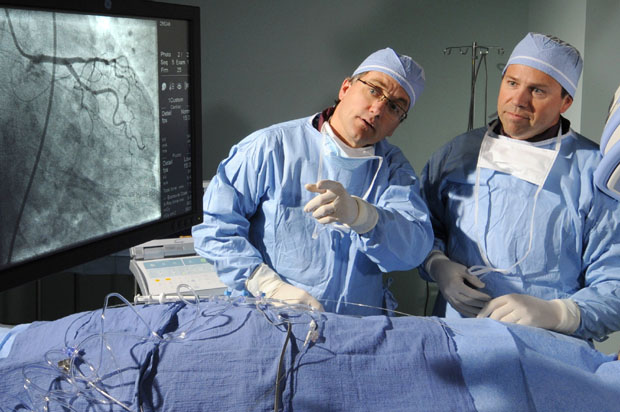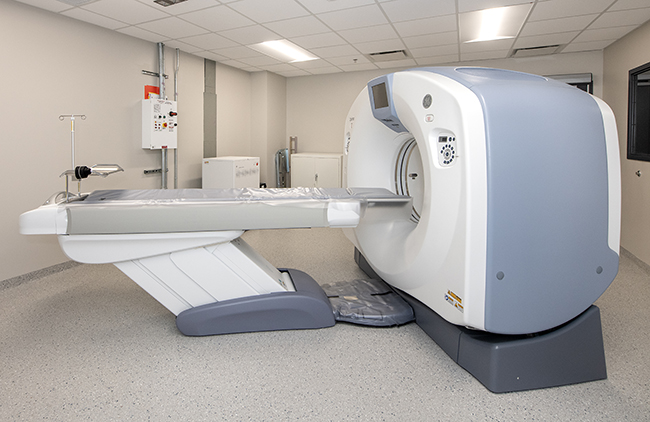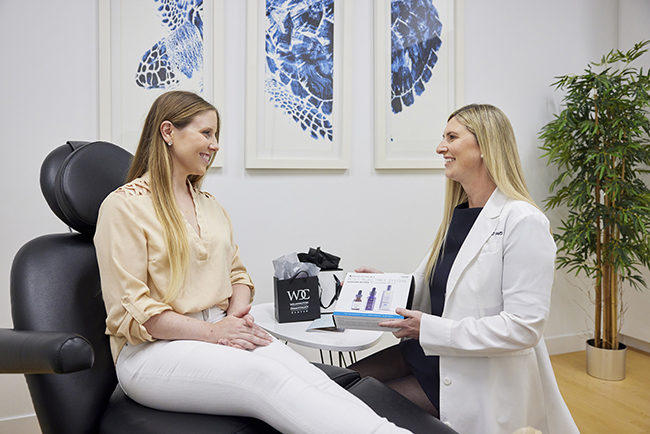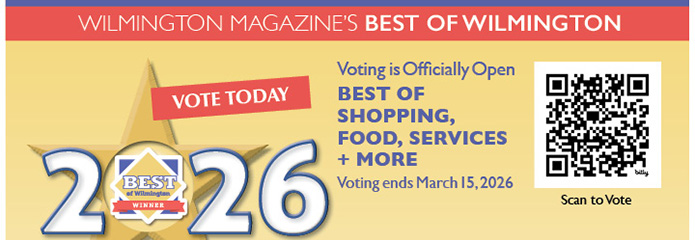How Healthy is Your Heart?
26 Jan 2014
For February’s annual Heart Awareness Month, we met with New Hanover Regional Medical Center staff members to discover some of the latest and greatest news in heart disease prevention and treatment
By BILLY COEUR

In February, it’s time to tend to matters of the heart. Between the Valentine’s Day cards, candy, dinners, and gifts (don’t forget the flowers) that occupy our minds, it seems we think of little else. But while we’re thinking about our hearts, take a moment to think about your actual heart. February is American Heart Month and, much in the same way October’s Pink Ribbon Campaign raises awareness and funding for breast cancer and breast cancer research, more and more people are wearing red, participating in Red Dress events or the National Wear Red Day (February 7 in 2014).
And they should.
Why? Because as widespread as the awareness, testing, and funding for breast cancer may be, heart disease is far deadlier for women and it’s impact on men’s health is equally profound. Nearly a million men and women will die from cardiovascular disease this year, with women accounting for more than half of that number.
“It’s astounding,” said David Parks, Vice President of Wilmington’s New Hanover Regional Medical Center (NHRMC) Heart Center. “The numbers are astounding. Fortunately for the women and men in our area, we have a fantastic Heart Center that can help with everything from diagnostic and corrective procedures to education and outreach.”
Dr. Martin Conley, a cardiologist with Hanover Medical Specialists, says, “Knowing your risk factor level – which you should discuss with your primary care physician – is a big step in combating heart ailments. This education is on the base level, but up until now, we had too many people not in the system. They had no way to learn about heart health from their doctor. Hopefully that will change soon and we’ll see fewer fatalities.
The Heart Center at NHRMC is the only one of its kind in Southeastern North Carolina, which means that when a patient has needs relating to matters of the heart, nearly every specialist in the region will make use of the facilities and expertise they offer.
At the Heart Center, 29 cardiologists and three cardiovascular surgeons are part of a huge team of radiologists, nurses, doctors, and technicians whose specialties and expertise are all oriented toward heart health. High-tech and non- and minimally-invasive procedures – like the Cardiac Calcium Scoring study, in which a 64-slice CT scan creates a highly detailed image of the heart which is read by a specially-trained radiologist who’s on the lookout for calcified plaque in the coronary arteries – make diagnosis and treatment far easier and far more successful than in the past.
“In the last decade, the techniques and skills doctors and surgeons can use to repair the heart is amazing. One of the techniques is the Trans Catheter Valve Replacement. This procedure uses catheters inserted into the femoral artery and routed to the heart to place new valves over faulty ones in the heart. The technique was developed for the benefit of patients too ill for open heart surgery, but has been refined to the point to where it’s an option for some other patients as well,” says Parks.
As techniques continue to evolve, procedures like this will become more viable for an expanding contingent of patients. Already, traditional open heart surgery is changing to reflect advances in techniques and technology. For some conditions, it’s no longer necessary to access the heart by going through the sternum and opening the chest cavity. Today, a number of surgeries can be performed by opening a “window” in the chest to access specific areas of the heart. This decreases patient pain, discomfort, recovery time, and in many cases, risk.
In addition to the diagnostic and corrective services offered by the Heart Center, one of the most valuable programs is their cardiac rehabilitation program. Here, patients are educated in proper dietary and exercise practices that will offer them the best chance of a long-term recovery. Generally a six-week program for post-surgery and post-heart-attack patients, a skilled staff of nurses and exercise physiologists help patients work to get back to their old lifestyle.
“That means our Cardiac Rehab staff have heard it all,” says Parks. “Not only do they answer questions about diabetes or exercise programs or diet, they answer a lot of other ones as well. The most common question, that’s probably ‘How soon can we have sex?’”
Though some patients may be a little embarrassed to ask, the answer is important. As a physical activity, sex increases the heart rate, which increases stress, which can acerbate unresolved heart issues. The Cardiac Rehab program is designed to incrementally increase the strength and endurance of the heart, returning to the point where strenuous activities like sex and exercise, or even activities like climbing a long flight of stairs, carrying in the groceries, or walking to the mailbox, aren’t a cause for concern.
While it’s great to know a resource like the Heart Center is there, how do you know if you need to visit?
The symptoms of a cardiac event – be it heart attack or the early signs of heart disease – can often be easy to spot. In men, sudden pain radiating from the left arm is a sign of a cardiac event; for women, that pain often originates in the jaw, neck, and upper back. For everyone, chest pain, palpitations (or a fluttering feeling in the heart), dizziness, and nausea are causes for concern and reason enough to call 911 for help.
“We talk a lot about what techniques and procedures can help reduce cardiac fatalities, but one of the biggest things that you can do is call 911 if you even suspect you’re having a heart attack or some other issue with your heart,” Young says. “A quick response is among the best treatments for heart attacks, so don’t wait. If you’re mistaken, the 911 operator, EMTs, firemen, whoever, aren’t going to be angry with you, so call; it’s better safe than sorry.”
NHRMC’s Heart Center has been working with emergency services and medical providers in seven surrounding counties – including Pender, Bladen, Brunswick, Columbus, Duplin, and Onslow Counties in North Carolina, and Horry County, South Carolina – to improve response times to cardiac incidents. In most cases, patients can begin receiving life-saving and damage-reducing care in a hospital in 44 minutes or less, far less than the national average of 90 minutes. Many ambulances, fire trucks, police cars, and rescue vehicles are equipped with AEDs (automatic electronic defibrillators), updated versions of the “paddles” we’ve seen on countless medical dramas. A growing number of emergency vehicles are equipped with cold packs used to cool the body of a patient, a technique that slows damage to the circulatory system in the event of a cardiac episode.
This February, make it a point to educate yourself on heart health issues. Learn the signs and symptoms of trouble, ask your doctor about risk factors, make changes to your diet and exercise habits if you need to. Above all, know that if you or someone you care for experiences a cardiac episode, call 911 and put them in the hands of the highly-trained, highly-skilled medical professionals who know how to get you or your loved ones back on track.
Heart Disease at A Glance
By the Numbers:
- Every year, nearly half a million women die from cardiovascular disease (that’s just over half of the total heart disease deaths)
- Breast cancer kills 1:31 women in the U.S. annually; heart disease causes 1:3
- Heart disease is more deadly than all forms of cancer combined
- Cardiovascular disease affects races and ethnicities differently: Hispanic women are likely to develop the disease 10 years earlier than their Caucasian counterparts, and it is the leading cause of death among African American women (46.9 percent of African American women ages 20 and older have cardiovascular disease)
- According to the American Heart Association 1:5 women have some form of heart disease
- And 90 percent of women have one or more risk factors for developing heart disease
- Heart disease is also the number one cause of death for men in the U.S.
- More than 920,000 Americans will have a heart attack this year, nearly half of them will occur without prior symptoms or warning signs
Symptoms:
- Chest pain or discomfort (called angina)
- Neck, jaw and throat pain (especially in women)
- Sudden indigestion, heartburn or nausea
- Shortness of breath
- Extreme fatigue
Risk Factors:
- Family History
- Race (African Americans, Native Americans and Hispanics are more likely to have heart disease than Caucasians)
- High LDL, the “bad” cholesterol
- Uncontrolled (or undiagnosed) hypertension (high blood pressure)
- Uncontrolled or undiagnosed diabetes
- Obesity
- Physical inactivity
- Age
- Hormonal conditions such as menopause and andropause
What You Can Do:
- Exercise 30-60 minutes a day, five days a week
- Maintain a healthy diet, meaning one low in saturated fat, cholesterol (especially LDL) and salt
- Modify your diet to include more vegetables (steamed and roasted are better than sautéed), fish and lean meats
- Don’t start smoking, and if you’re a smoker, quit
- Keep your diabetes under control
Fortunately for You:
- NHRMC’s Heart Center is home to 29 cardiologists, 3 cardiovascular surgeons and too many nurses to count
- The Heart Center performs more than 550 surgical procedures and 12,000 diagnostic procedures annually
In 2012, the Heart Center received the American Heart Association’s Mission: Lifeline Gold Quality Achievement Award; only 25 hospitals in the nation received this honor














